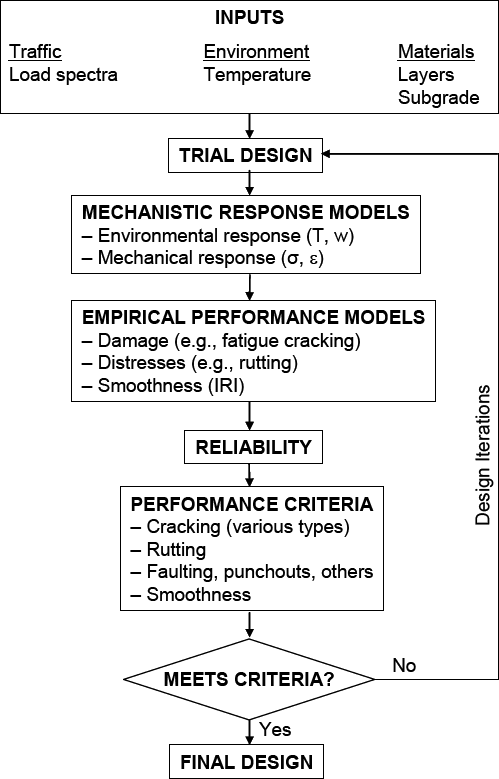
- #1993 aashto guide for design of pavement structures software
- #1993 aashto guide for design of pavement structures code
Vehicles Type Light vehicle less than 5 t Truck Loading HS-20-44 36 t

Single Single Single Tandem Tandem Single SingleĢ03.2 mm -0.301 = G then Lx 5 5 8 32 32 20 20 60 60 Vehicles Type Light vehicle less than 5 t Traffic 20 vehicles/day/week/2 lanes 20 vehicles/day/week/2 lanes 60 vehicles/day/week/2 lanes 60 vehicles/day/week/2 lanes 60 vehicles/day/week/2 lanes 1 vehicles/day/week/2 lanes 1 vehicles/day/week/2 lanes 1 vehicles/day/week/2 lanes 1 vehicles/day/week/2 lanesĪt first assumed D slab thickness is service ability designed in good condition ROAD & HEAVY DUTY PAVEMENT DESIGN UR =Ģ.1 HEAVY DUTY PAVEMENT AND ROAD - LAYER DESIGN Pavement : Sub Base : Subgrade : CBR minĢ.2 EQUIVALENT SINGLE AXLE LOAD - ESAL Vehicles Type Light vehicle less than 5 tĪxle Single Single Single Tandem Tandem Single SingleĪxle Load (ton) (kip) 2.5 5 2.5 5 4 8 16 32 16 32 10 20 10 20 30 60 30 60 Wiremesh Deformed Bar Plain Bar Steel Specific Gravityįor Leveling Concrete For Road and PavementĢ. Spesific Codes and Standard TPP-00-A0-ES-001-R Design Specification for Civil & Structuralġ.4 USED MATERIAL AND ALLOWABLE STRESS 1.4.1 Concrete Compressive Strength of concrete at 28 days ( Cilinder Test ) shall be as follows, unless otherwise specified fc' fc'ġ.4.2 Reinforcing Steel Bar Material Grade
#1993 aashto guide for design of pavement structures code
SKBI 1.3.53 - 1987 Indonesian Loading Code for BuildingĪCI 318 - 08 Building Code for Structural ConcreteĪSTM American Society for Testing and Materialġ.3.2. General Codes and Standard AASHTO 1993 Guide for Design of Pavement Structures.
#1993 aashto guide for design of pavement structures software
Computer Software that is used in design analysis MS Excelġ.3 CODE AND STANDARD 1.3.1. GENERAL 1.1 OUTLINE OF STRUCTURE Project Client Location Structure Nameġ.2 DESIGN PHILOSOPHY 1.2.1 Unit of Measurment Unit of measurment in design is in metric/imperial system 1.2.2. Unbound layer thicknesses are rounded to the nearest inch.TONASA 2 10-1026 XPT 35 SEMEN MW TONASA CFPPĭoc No. 44(2.0) (5.5) (D3) D3 = 7.73 inches Use D3 = 8.0 inches for construction.1 1After rounding to the nearest half-inch, per the recommendations in the 1993 AASHTO Design Guide.

From the City of El Paso and TxDOT guidelines, recommended base range 4-10 inches, Therefore D2 is equal to 5.5 inches Solving equation for subbase layer: 2.7=.

Values for design: a1 = 0.44, a2 = 0.14, and a3=0.11 Drainage coefficients mi for all unbound layers are set to 1.0įor the required overall structural number (SN) using software or excel solver: SN = 2.71.ġ2 Step 8: Determine the design layer thicknesses for the pavement section to apply to equation: From the City of El Paso guidelines, minimum HMA section (wearing surface) should not be less than 1.5 inches. Recommendations for appropriate ai values for design are given by 1993 AASHTO Design Guide. Structural layer coefficients ai for all bound layers. Reliability = 80% (local urban traffic), ZR = standard normal deviate =, S0 = standard deviation = 0.45 (most commonly used).ħ Step 4: Determine the allowable serviceability loss due to traffic (ΔPSI) ΔPSI = 2.2 given by equation: ΔPSI = pt− po=4.2−2.0=2.2 Values most commonly used for pt and poĨ Step 5: Evaluate the seasonally averaged subgrade resilient modulus MR using the formula: MR = 2555*(CBR) 0.64 MR = psi.ĩ Step 6: Determine the layer properties: Values for design: EAL=Equivalent Axle LoadingĦ Step 3: Determine the design reliability factors: Street Classification: Residential Sub-Collector From recommendations from the City of El Paso, W18 =269,000 EALs. (LEC):įor the design scenario, a 20-year design life is specified. All versions of the AASHTO Design Guide are empirical design methods based on field performance data measured at the AASHO Road Test inģ Design of a flexible pavement section requires the developers to establish a baseline scenario for the location where the pavement is going to be placed The steps in the 1993 AASHTO flexible pavement design procedure summarized below and are in the context of the baseline scenario presented by Licon Engineering Co. Approximately 80% of all states use the AASHTO pavement design procedures, with the majority using the 1993 version. Presentation on theme: "Calculating Dimensions for a Typical Pavement Section using 1993 AASHTO Flexible Pavement Design Guide."- Presentation transcript:ġ Calculating Dimensions for a Typical Pavement Section using 1993 AASHTO Flexible Pavement Design GuideĢ The AASHTO Guide for Design of Pavement Structures (AASHTO, 1993) is the primary document used to design new and rehabilitated highway pavements.


 0 kommentar(er)
0 kommentar(er)
